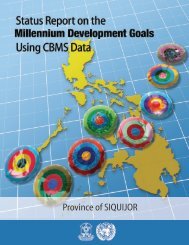Province of Romblon - UNDP in the Philippines
Province of Romblon - UNDP in the Philippines
Province of Romblon - UNDP in the Philippines
Create successful ePaper yourself
Turn your PDF publications into a flip-book with our unique Google optimized e-Paper software.
36<br />
Table 10: Magnitude and Proportion <strong>of</strong> Underweight Children Under 5 Years <strong>of</strong> Age, by Sex, by Urbanity, by Municipality, 2007<br />
Source: CBMS Database 2007<br />
<strong>the</strong> high proportion <strong>of</strong> poverty <strong>in</strong>cidence,<br />
it is <strong>in</strong>terest<strong>in</strong>g to note that only a scant<br />
proportion <strong>of</strong> <strong>the</strong> population experienced<br />
food shortage. This is due to <strong>the</strong> fact that<br />
<strong>Romblon</strong> is blest with abundant natural<br />
resources. One can get food <strong>in</strong> <strong>the</strong> forest,<br />
rivers and <strong>the</strong> vast surround<strong>in</strong>g seas.<br />
The LGUs that posted a two digit proportion<br />
<strong>in</strong> this particular <strong>in</strong>dicator are Magdiwang<br />
with 16.19 percent and San Fernando with<br />
10.32 percent, both <strong>in</strong> Sibuyan Island. These<br />
two municipalities have <strong>in</strong>digenous people<br />
liv<strong>in</strong>g <strong>in</strong> <strong>the</strong> mounta<strong>in</strong>s and are dependent<br />
on traditional farm<strong>in</strong>g. The rest <strong>of</strong> <strong>the</strong> LGUs<br />
posted zero or a low proportion <strong>of</strong> below<br />
5 percent.<br />
<strong>Prov<strong>in</strong>ce</strong> <strong>of</strong> <strong>Romblon</strong><br />
Prevalence <strong>of</strong> Underweight Children<br />
Under 5 years <strong>of</strong> Age<br />
In <strong>the</strong> case <strong>of</strong> <strong>the</strong> prov<strong>in</strong>ce <strong>of</strong> <strong>Romblon</strong>, <strong>the</strong><br />
<strong>in</strong>dicator on <strong>the</strong> prevalence <strong>of</strong> underweight<br />
children under five years old shows a<br />
very promis<strong>in</strong>g trend. Based on <strong>the</strong> data<br />
from <strong>the</strong> Office <strong>of</strong> <strong>the</strong> Prov<strong>in</strong>cial Nutrition<br />
Action Officer (PNAO), <strong>the</strong> malnutrition<br />
prevalence rate <strong>in</strong> 1991 for <strong>the</strong> prov<strong>in</strong>ce<br />
was recorded at 20.02 percent. The figure<br />
had steadily gone down s<strong>in</strong>ce. However,<br />
with <strong>the</strong> implementation <strong>of</strong> <strong>the</strong> International<br />
Reference Standard (IRS), a high 19.04<br />
percent was recorded <strong>in</strong> 2003. Data from<br />
<strong>the</strong> PNAO record <strong>of</strong> <strong>the</strong> yearly Operation<br />
Timbang (OPT) has shown a gradual<br />
Status Report on <strong>the</strong> Millennium Development Goals Us<strong>in</strong>g CBMS Data



